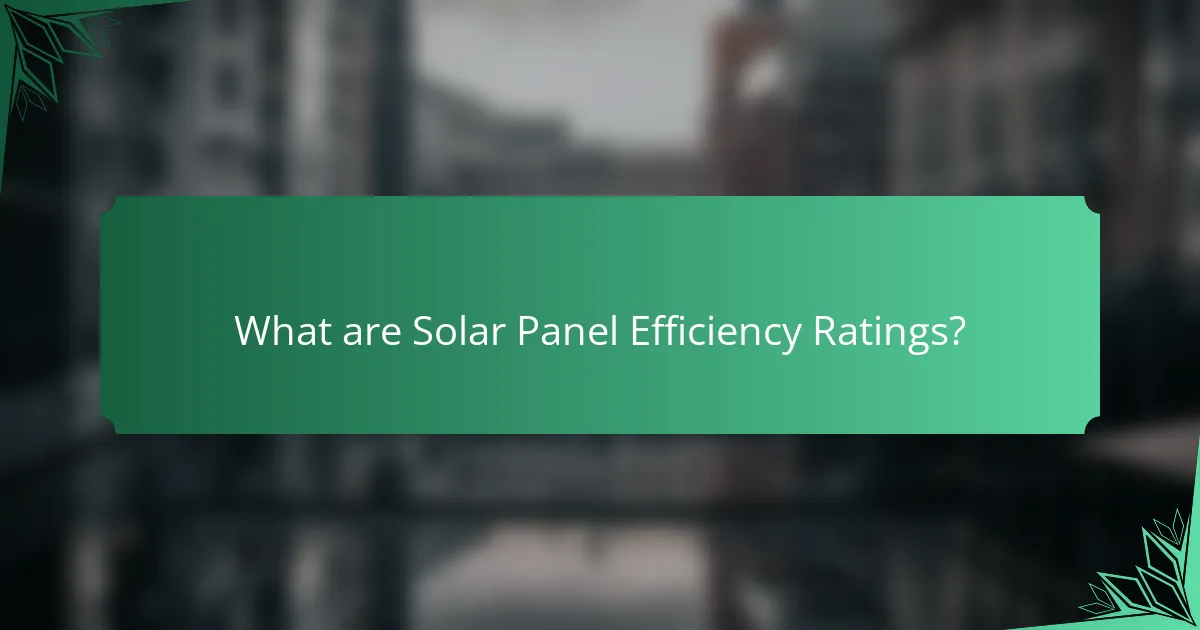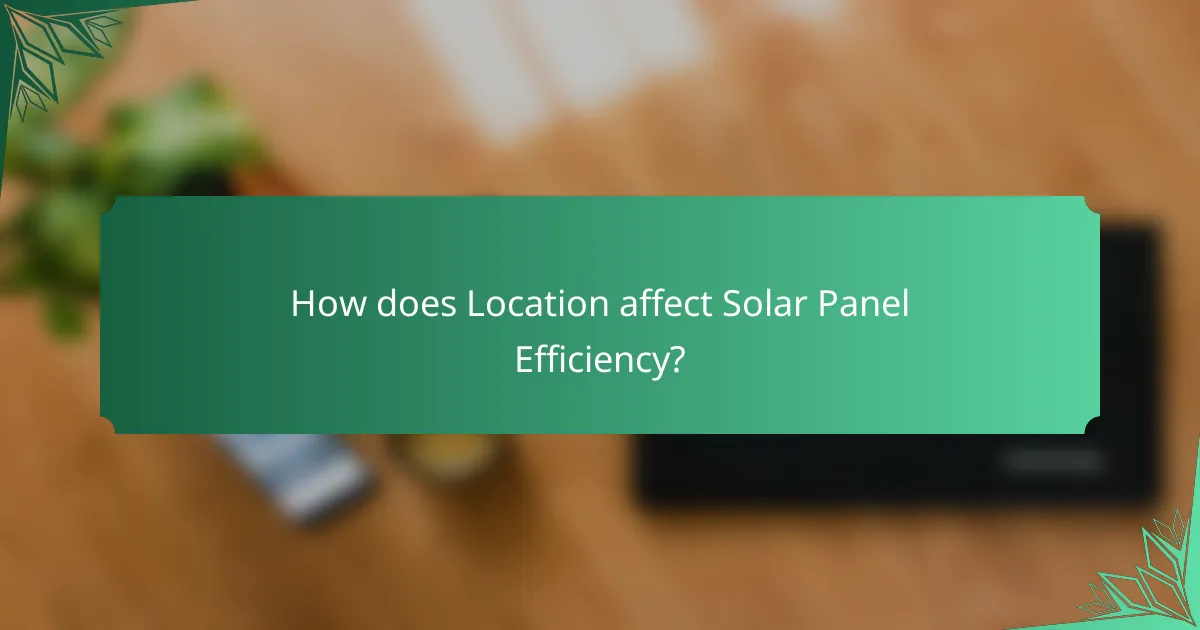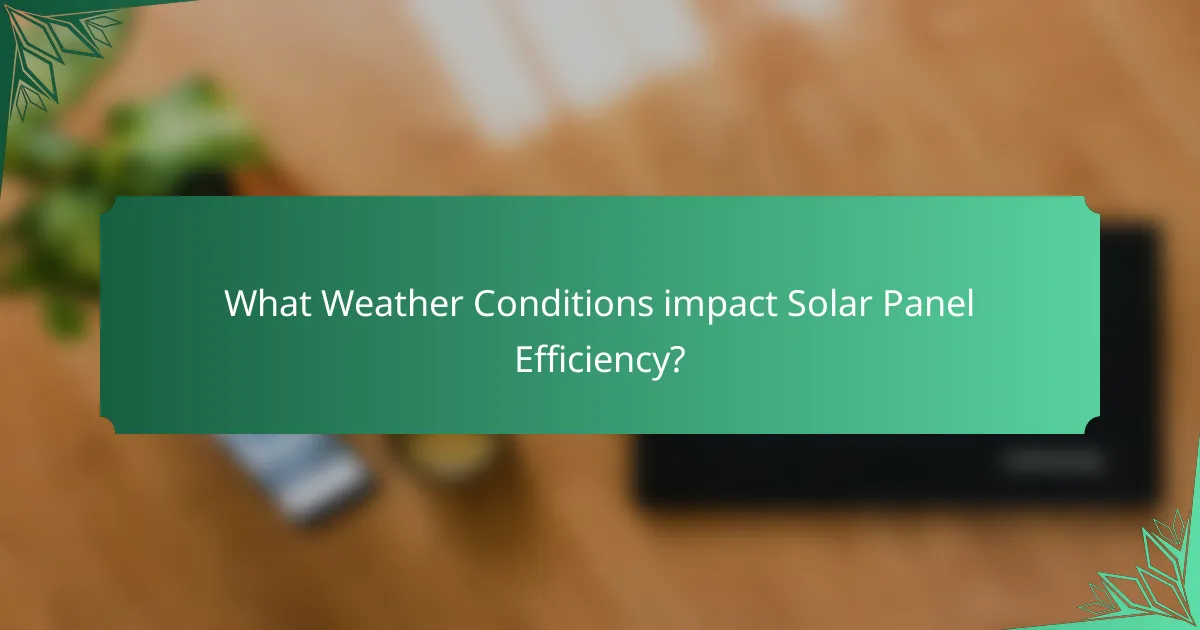
What are Solar Panel Efficiency Ratings?
Solar panel efficiency ratings measure how effectively a solar panel converts sunlight into usable electricity. These ratings are expressed as a percentage. Higher percentages indicate more efficient panels. For example, a panel with a 20% efficiency rating converts 20% of sunlight into electricity. Efficiency ratings are determined through standardized testing conditions. These conditions include specific light intensity and temperature. The efficiency of solar panels can be influenced by factors such as location and weather conditions. For instance, panels may perform differently in cloudy conditions compared to sunny ones.
How are Solar Panel Efficiency Ratings calculated?
Solar panel efficiency ratings are calculated by measuring the amount of sunlight converted into usable electricity. This is expressed as a percentage of the total solar energy that hits the panel. To determine this rating, solar panels are tested under standardized conditions, known as Standard Test Conditions (STC). These conditions include a temperature of 25 degrees Celsius, a solar irradiance of 1000 watts per square meter, and an air mass of 1.5.
During testing, the output power of the solar panel is measured. The efficiency rating is then calculated by dividing the output power by the input solar power and multiplying by 100. For example, if a panel produces 300 watts of power under STC, its efficiency rating is calculated as (300 watts / 600 watts) x 100, resulting in a 50% efficiency rating.
This method allows for consistent and comparable efficiency ratings across different solar panels. The efficiency rating helps consumers understand how well a solar panel converts sunlight into electricity.
What factors contribute to the efficiency of solar panels?
The efficiency of solar panels is influenced by several key factors. These factors include the type of solar cells used, the angle of installation, and the amount of sunlight received. Monocrystalline solar panels generally offer higher efficiency compared to polycrystalline panels. The angle of installation affects how much sunlight the panels capture throughout the day. Optimal angles vary based on geographical location and season.
Temperature also plays a significant role; solar panels typically perform better in cooler conditions. Dust and debris on the surface can reduce efficiency by blocking sunlight. Additionally, inverter quality impacts the overall energy conversion efficiency. Research shows that high-quality inverters can increase energy output by up to 20%.
Moreover, shading from nearby objects can significantly decrease solar panel efficiency. Regular maintenance and cleaning can help maintain optimal performance. Understanding these factors is essential for maximizing solar panel efficiency in any installation.
How do different types of solar panels compare in efficiency ratings?
Monocrystalline solar panels typically have the highest efficiency ratings, ranging from 15% to 22%. Polycrystalline panels follow with efficiency ratings between 13% and 16%. Thin-film solar panels generally exhibit lower efficiency, around 10% to 12%.
The efficiency of monocrystalline panels is attributed to the purity of silicon used. This allows for better electron movement and higher energy conversion. Polycrystalline panels, while less efficient, are often more affordable due to simpler manufacturing processes.
Thin-film panels are lightweight and flexible but require more space for the same energy output. Their lower efficiency is compensated by their versatility in installation.
Research indicates that location and weather conditions also significantly impact panel performance. For instance, monocrystalline panels perform better in low-light conditions compared to others. This makes them suitable for areas with variable sunlight.
In summary, the type of solar panel directly influences efficiency ratings, with monocrystalline being the most efficient, followed by polycrystalline and thin-film options.
Why are Solar Panel Efficiency Ratings important?
Solar panel efficiency ratings are important because they indicate how effectively a solar panel converts sunlight into electricity. Higher efficiency ratings mean more energy production from the same amount of sunlight. This is crucial for maximizing energy output, especially in limited space. For example, a panel with 20% efficiency produces more energy than one with 15% efficiency under identical conditions. In addition, efficiency ratings help consumers compare products and make informed purchasing decisions. They also influence the overall cost-effectiveness of solar energy systems. According to the National Renewable Energy Laboratory, improvements in efficiency can significantly reduce the payback period for solar investments.
What impact do efficiency ratings have on energy production?
Efficiency ratings significantly influence energy production from solar panels. Higher efficiency ratings indicate that panels convert more sunlight into usable electricity. For instance, a solar panel with a 20% efficiency rating generates more energy than one with a 15% rating under identical conditions. This difference can lead to increased energy output over the panel’s lifespan. According to the National Renewable Energy Laboratory, high-efficiency panels can produce up to 30% more energy in the same area compared to lower-rated panels. Therefore, efficiency ratings are crucial for optimizing energy production in solar energy systems.
How do efficiency ratings influence consumer choices?
Efficiency ratings significantly influence consumer choices by providing a clear measure of a solar panel’s performance. Higher efficiency ratings indicate that a panel can convert more sunlight into electricity. This efficiency directly impacts potential energy savings and return on investment. Consumers often prefer panels with higher ratings to maximize their energy output. According to the U.S. Department of Energy, solar panels with efficiency ratings above 20% are considered high-performing. This preference can lead to increased sales for manufacturers offering top-rated products. Additionally, consumers may use efficiency ratings to compare different brands and models. Thus, efficiency ratings serve as a critical factor in guiding informed purchasing decisions in the solar panel market.

How does Location affect Solar Panel Efficiency?
Location significantly affects solar panel efficiency. Solar panels perform optimally in areas with high solar irradiance. Regions closer to the equator generally receive more sunlight throughout the year. This increased sunlight translates to higher energy production. Additionally, geographic factors like altitude can influence efficiency. Higher altitudes often have clearer skies, which can enhance performance. Weather patterns also play a role; areas with frequent cloud cover reduce solar energy capture. According to the National Renewable Energy Laboratory, solar panels in sunny regions can produce 20-30% more energy than those in cloudy regions. Thus, location is a critical determinant of solar panel efficiency.
What geographical factors influence solar panel performance?
Geographical factors significantly influence solar panel performance. Key factors include latitude, altitude, and climate conditions. Latitude affects the angle of sunlight received. Areas closer to the equator generally receive more direct sunlight. Altitude impacts atmospheric thickness, with higher altitudes allowing more sunlight to reach solar panels. Climate conditions such as temperature, humidity, and cloud cover also play a role. Higher temperatures can reduce panel efficiency, while increased humidity may lead to more cloud cover, limiting sunlight exposure. According to the National Renewable Energy Laboratory, optimal solar performance occurs in regions with high solar irradiance and minimal atmospheric interference.
How does latitude affect solar energy generation?
Latitude significantly affects solar energy generation. As latitude increases, the angle of sunlight becomes more oblique. This results in less solar energy being captured per unit area. Areas closer to the equator receive more direct sunlight throughout the year. Conversely, regions near the poles experience seasonal variations in sunlight. For instance, during winter months, polar regions may have very limited sunlight. Research shows that solar panel efficiency can drop by up to 50% in high-latitude areas. This indicates that latitude is a critical factor in optimizing solar energy systems.
What role does urban versus rural placement play in efficiency?
Urban placement typically leads to lower solar panel efficiency compared to rural placement. This is due to several factors, including shading from tall buildings and increased air pollution in urban areas. Shading can significantly reduce the amount of sunlight that solar panels receive. Studies show that urban areas can experience up to 40% less solar energy due to these obstructions. In contrast, rural areas generally have fewer obstructions and cleaner air, allowing for more direct sunlight and optimal solar panel performance. Additionally, rural locations often have larger available spaces, facilitating the installation of more solar panels. Therefore, rural placement can enhance overall solar energy efficiency significantly.
How does local climate impact solar panel efficiency?
Local climate significantly impacts solar panel efficiency. Temperature affects the electrical output of solar panels. Higher temperatures can reduce efficiency by causing increased resistance in the panels. For instance, solar panels operate best at around 25 degrees Celsius. Beyond this temperature, every degree increase can decrease efficiency by approximately 0.5%.
Additionally, sunlight availability is crucial. Regions with consistent, direct sunlight enhance energy production. Conversely, cloudy or rainy climates lead to reduced solar generation. Humidity can also affect performance, as moisture can lead to panel degradation over time.
Moreover, snowfall can temporarily block sunlight. However, panels can often shed snow due to their angle. Wind can help cool panels, potentially improving efficiency in hot climates. Overall, local climate conditions play a critical role in determining the effectiveness of solar energy systems.
What weather conditions are most favorable for solar energy production?
Sunny and clear weather conditions are most favorable for solar energy production. High solar irradiance directly enhances the efficiency of solar panels. Optimal temperatures for solar energy production range from 15°C to 35°C. Excessive heat can reduce solar panel efficiency. Low humidity levels also contribute positively to solar energy output. Cloud cover significantly diminishes solar energy generation. Wind can help cool solar panels, improving their efficiency. Therefore, a combination of sunny skies, moderate temperatures, and low humidity maximizes solar energy production.
How do seasonal changes affect solar panel output?
Seasonal changes significantly affect solar panel output. Solar panels generate more electricity during summer due to increased sunlight and longer daylight hours. In contrast, winter typically sees reduced output because of shorter days and potential snow cover. Spring and fall can yield variable performance depending on cloud cover and weather conditions.
For example, solar output can decrease by 20-30% in winter months in northern climates. Research shows that solar panels can lose efficiency in temperatures below 25°C (77°F). Additionally, dust and debris accumulation during certain seasons may further reduce energy production. These factors illustrate how seasonal variations directly impact solar energy generation.

What Weather Conditions impact Solar Panel Efficiency?
Weather conditions significantly impact solar panel efficiency. High temperatures can reduce the efficiency of solar panels. Studies show that solar panel output decreases by about 0.5% for every degree Celsius above 25°C. Conversely, cooler temperatures can enhance efficiency. Cloud cover reduces solar irradiance, leading to lower energy production. Snow can block sunlight but may also reflect light onto panels when melted. Rain can clean panels, improving performance. Wind can help cool panels, maintaining higher efficiency levels. Humidity affects output by influencing the amount of sunlight reaching the panels. Overall, these weather factors collectively determine solar panel performance.
How does temperature influence solar panel performance?
Temperature significantly influences solar panel performance. As temperature increases, the efficiency of solar panels typically decreases. Most solar panels are rated at 25 degrees Celsius. At higher temperatures, the voltage output of the panels drops. This drop can lead to a reduction in overall energy production. For instance, a common reduction rate is about 0.5% per degree Celsius above the rated temperature. Therefore, in hotter climates, solar panels may underperform compared to cooler conditions. This performance variation is crucial for system design and energy yield predictions.
What is the optimal temperature range for solar panels?
The optimal temperature range for solar panels is between 15°C to 35°C (59°F to 95°F). Solar panels operate most efficiently within this temperature range. Performance tends to decrease as temperatures rise above this range. High temperatures can lead to a drop in energy output. For instance, a temperature increase of 1°C can reduce efficiency by about 0.5%. This relationship between temperature and efficiency is well-documented in solar technology studies. Therefore, maintaining a cooler environment is beneficial for maximizing solar panel performance.
How does overheating affect solar panel efficiency?
Overheating reduces solar panel efficiency. As temperature increases, the electrical output of solar cells decreases. Typically, solar panels operate optimally at lower temperatures. For every degree Celsius above 25°C, efficiency can drop by about 0.5% to 0.8%. High temperatures can lead to increased resistance in the solar cells. This resistance results in lower voltage output. In extreme cases, overheating can cause permanent damage to the panels. Studies show that maintaining optimal operating temperatures is crucial for maximizing energy production.
What is the effect of cloud cover and precipitation on solar panels?
Cloud cover and precipitation reduce the efficiency of solar panels. Solar panels rely on direct sunlight to generate electricity. Increased cloud cover leads to lower solar irradiance. This results in decreased energy production. Precipitation, such as rain or snow, can further impact performance. Rain can clean panels but also block sunlight. Snow accumulation on panels can significantly reduce output. Studies show that solar efficiency can drop by 10-25% under cloudy conditions. The specific reduction varies by panel type and local climate.
How do cloudy days compare to sunny days in terms of energy output?
Cloudy days produce less energy output compared to sunny days. Solar panels generate energy primarily from sunlight. On cloudy days, the sunlight is diffused and reduced, leading to lower energy production. Studies show that solar panels can produce 10% to 25% of their maximum output on overcast days. In contrast, sunny days allow solar panels to operate at or near their peak efficiency. This difference is due to the direct sunlight available, which enhances the panels’ performance. Therefore, the energy output on cloudy days is significantly diminished compared to sunny conditions.
What measures can be taken to mitigate the effects of rain or snow?
To mitigate the effects of rain or snow on solar panels, several measures can be implemented. Installing solar panels at an angle helps prevent snow accumulation. This angle allows rain and snow to slide off more easily. Regular maintenance is essential for optimal performance. Cleaning panels removes debris that can block sunlight. Using heated panels can also reduce snow buildup. These panels utilize electric heating elements to melt snow. Additionally, incorporating wind barriers can protect panels from heavy snowfall. These barriers redirect snow away from the solar installation. Implementing these measures enhances solar panel efficiency during adverse weather conditions.
What are the best practices for maximizing solar panel efficiency?
To maximize solar panel efficiency, ensure optimal placement and angle. Position panels to receive maximum sunlight exposure throughout the day. The ideal angle typically matches the latitude of the installation location. Regularly clean the panels to remove dust and debris that can block sunlight. Avoid shading from nearby trees or buildings, as even partial shading can significantly reduce output. Monitor system performance to identify any drops in efficiency. Upgrading to high-efficiency panels can also enhance energy production. According to the U.S. Department of Energy, proper maintenance and optimal installation can improve solar energy output by up to 20%.
How can regular maintenance improve solar panel performance?
Regular maintenance can significantly improve solar panel performance. It ensures that panels remain clean and free of debris. Clean panels absorb more sunlight, leading to higher energy production. Regular inspections can identify issues like loose connections or damaged components. Addressing these problems promptly prevents energy loss. Studies show that well-maintained solar systems can operate at up to 95% efficiency. Neglecting maintenance can reduce efficiency by 20% or more. Therefore, routine care is essential for optimal solar panel function.
What installation tips can enhance solar panel efficiency based on location and weather?
To enhance solar panel efficiency based on location and weather, proper installation is crucial. Panels should be installed at an optimal angle. The ideal angle often corresponds to the latitude of the installation site. This angle allows for maximum sunlight exposure throughout the year.
Additionally, avoiding shading is essential for efficiency. Trees, buildings, or other structures can block sunlight and reduce output. It is recommended to assess potential shading during different times of the day.
Furthermore, consider the local climate. In areas with heavy snowfall, panels should be installed with a steeper tilt. This helps snow slide off and prevents accumulation. Conversely, in hot climates, proper ventilation is necessary. Adequate airflow can help keep panels cool and maintain performance.
Regular maintenance is also vital. Cleaning panels to remove dust and debris ensures they capture as much sunlight as possible. Studies show that dirty panels can lose up to 25% of their efficiency.
Finally, consult local solar experts for tailored advice. They can provide insights based on regional conditions and specific site characteristics.
The main entity of this article is solar panel efficiency ratings, which measure the effectiveness of solar panels in converting sunlight into usable electricity. The article provides a detailed analysis of how these efficiency ratings are calculated, the factors influencing them, and the variations among different types of solar panels. Additionally, it explores the impact of geographical location and weather conditions on solar panel performance, highlighting how elements such as temperature, sunlight availability, and maintenance practices can optimize energy production. Key insights into consumer choices based on efficiency ratings and best practices for maximizing solar panel output are also discussed.